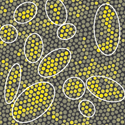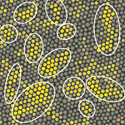Universality of the glass transition
A molecular liquid cooled to below its freezing point (i.e., supercooled) can become a glass. A colloidal fluid, a collection of suspended particles undergoing Brownian motion, can form a colloidal glass under increasing pressure.
Though both scenarios are examples of the so-called glass transition, researchers have disagreed on whether the two phenomena are related, that is, on whether temperature or pressure plays a more important role in the formation of a glass. Ning Xu at the Chinese University of Hong Kong, Thomas Haxton and Andrea Liu at the University of Pennsylvania, and Sidney Nagel at the University of Chicago, both in the US, explain in a paper published in Physical Review Letters that there is a limit in which the relaxation behavior near the glass transition can be understood without separately invoking temperature and pressure ; the data collapses on a curve determined by their ratio . This equivalence indicates that there is indeed a hitherto overlooked universal aspect to glass transition. – Sami Mitra





